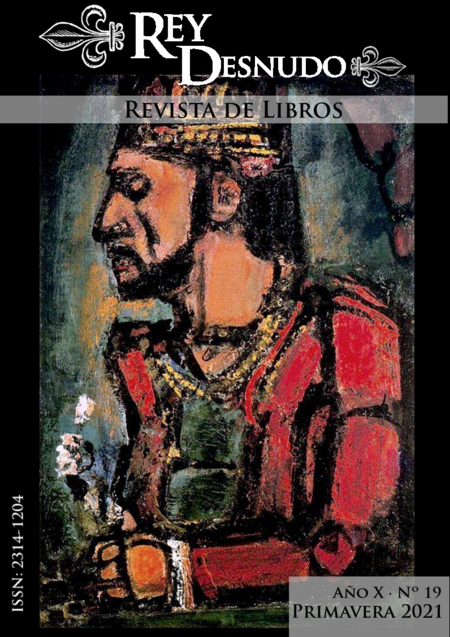Jochen Böhler, Ota Konrád y Rudolf Kucera, In the Shadow of the Great War. Physical Violence in East-Central Europe, 1917-1923 (Nueva York: Bergahn Books, 2021).
Contenido principal del artículo
Detalles del artículo

Esta obra está bajo una licencia internacional Creative Commons Atribución-CompartirIgual 4.0.
Los autores/as que publiquen en esta revista aceptan las siguientes condiciones:
- Los autores/as conservan los derechos de autor y ceden a la revista el derecho de la primera publicación, con el trabajo registrado con la licencia de atribución de Creative Commons, que permite a terceros utilizar lo publicado siempre que mencionen la autoría del trabajo y a la primera publicación en esta revista.
- Los autores/as pueden realizar otros acuerdos contractuales independientes y adicionales para la distribución no exclusiva de la versión del artículo publicado en esta revista (p. ej., incluirlo en un repositorio institucional o publicarlo en un libro) siempre que indiquen claramente que el trabajo se publicó por primera vez en esta revista.
- Se permite y recomienda a los autores/as a publicar su trabajo en Internet (por ejemplo en páginas institucionales o personales) antes y durante el proceso de revisión y publicación, ya que puede conducir a intercambios productivos y a una mayor y más rápida difusión del trabajo publicado (vea The Effect of Open Access).
Citas
Adan Kovacsics, “Guerra y lenguaje”, en Guerra y lenguaje (Barcelona: Acantilado, 2007), 67-136.
Adam Kozuchowski, “The Last Hundred Years. Some Observations on the Historiography of Austria-Hungary”, RADOVI. Zavod za hrvatsku povijest 50 (2018): 119-33.
Aliaksandr Piahanau, “Hungarian War Aims during WWI: Between Expansionism and Separatism”, Central European Papers 2, no. 2 (2014), 95-107.
Alan Sked, “Austria-Hungary and the First World War”, Historie@Politique. Politique, culture, société 22 (Enero-Abril de 2014).
Samuel Williamson Jr., “Austria and the Origins of the Great War: A Selective Historiographical Survey”, en 1914. Austria-Hungary, the Origins and the First Year of World War I, ed. Gunther Bischof y Ferdinand Karlhofer (Nueva Orleans: University of New Orleans Press, 2014), 21-34.
Jochen Böhler, Civil War in Central Europe, 1918-1921. The Reconstruction of Poland (Oxford: Oxford University Press, 2018).
Ota Konrád, “Two Post-War Paths: Popular Violence in the Bohemian Lands and in Austria in the Aftermath of World War I”, Nationalities Papers 49, no. 5 (Septiembre de 2018): 759-75.
Rudolf Ku?era, Rationed Life. Science, Everyday Life and Working-Class Politics in the Bohemian Lands, 1914-1918 (Nueva York: Bergahn Books, 2016).
Ken Follett, Fall of Giants (Londres: Penguin, 2012).
Olivier Compagnon y Pierre Purseigle: “Geographies of mobilization and territories of belligerance during the First World War”, Annales HSS 71, no. 1 (2016): 37-60.
John Horne y Robert Gerwart, eds. War in Peace. Paramilitary Violence in Europe after the Great War (Oxford: Oxford University Press, 2012).
Robert Gerwarth, The Vanquished. Why the First World War Failed to End, 1917-1923 (Londres: Allen Lane, 2016).
Jay Winter, “General introduction”, en The Cambridge History of the First World War (I), ed. Jay Winter (Cambridge: Cambridge University Press, 2013), 1-10.
Omer Bartov y Eric Weitz, eds. Shatterzone of Empires. Coexistence and Violence in the German, Habsburg, Russian and Ottoman Borderlands (Bloomington, IN: Indiana University Press, 2013).
Randall Collins, Violence. A Micro-Sociological Theory (Princeton, NJ: Princeton University Press, 2008).
Peter Haslinger, “Frontiers of Violence. Paramilitärs als Gewaltgemeinschaften im Ostmitteleuropa der 1920er Jahre”, en Gewaltgemeinschaften in der Geschicte. Entesehun, Kohäsionskraft und Zerfall, ed. Winfried Speitkamp (Gotinga: Vandenhoeck & Ruprecht, 2017), 233-54.
Gerwarth y Horne, op.cit.; y Piotr Wrobel, “Seeds of Violence. The Brutalization of an East European Region, 1917-1921”, Journal of Modern European History 1, no. 1 (2003): 125-49.
Susan Brownmiller, Against our Will. Men, Women and Rape (Nueva York: Simon & Schuster, 1975).
Ann Cahill, Rethinking rape (Ithaca, NY: Cornell University Press, 2001).
Ruth Siefert, “War and Rape: A Preliminary Analysis”, en Mass Rape. The War against Women in Bosnia-Herzegovina, ed. Alexandra Stiglmayer (Lincoln, NE: University of Nebraska Press, 1994).
Robert Gerwarth, “Sexual and Non-Sexual Violence against ‘Politicised Women’ after the Great War”, en Sexual Violence in Conflict Zones from the Ancient World to the Late Twentieth Century, ed. Elisabeth Heinemann (Philadelphia, PA: University of Pennsylvania Press, 2011).
Susan Grayzel, “Women and Men”, en A Companion to World War I, ed. John Horne (Oxford: Wiley-Blackwell, 2010).
Dagmar Herzog, “Introduction: War and Sexuality in Europe's Twentieth Century”, en Brutality and Desire. War and Sexuality in Europe's Twentieth Century, ed. Dagmar Herzog (Basingstoke: Palgrave Macmillan, 2011).
Maria Hermes, Krankheit: Krieg. Psychiatrische Deutungen des Ersten Weltkrieges (Essen: Klartext Verlag, 2012).
Hans-Georg Hoger, Nervenschwäche und Krieg. Modernitätskritik und Krisenbewältigung in der österreichischen Psychiatrie, 1880-
(Viena: Böhlau Verlag, 2004).
Paul Lerner, Hysterical Men. War, Psychiatry and the Politics of Trauma in Germany (Ithaca, NY: Cornell University Press, 2003).
María Bjerg, “Una genealogía de la historia de las emociones”, Quinto Sol 23, no. 1 (Enero-Abril de 2019): 1-20.
Jan Philipp Reemtsma, Vertrauen und Gewalt. Versuch über eine besondere Konstellation der Moderne (Hamburgo: Verlag Hamburger, 2008).
Michel Foucault, Vigilar y castigar. Nacimiento de la prisión (Buenos Aires: Siglo XXI, 2008 [orig. francés 1975]).
Michel Foucault, Teorías e instituciones penales. Curso en el Collège de France (1971-1972) (México: Fondo de Cultura Económica, 2021 [orig. francés 2015]).
Giorgio Agamben, Homo sacer. El poder soberano y la vida desnuda (Buenos Aires: Adriana Hidalgo, 2017 [orig. italiano 1995]).
Émile Durkheim, El suicidio (Buenos Aires: Losada, 2004 [orig. francés 1897]).
Sigmund Freud, Más allá del principio del placer (Buenos Aires: Amorrortu, 2014 [orig. alemán 1920]).
Donald E. David y Eugene P. Trani, The First Cold War. The Legacy of Woodrow Wilson in US-Soviet Relations (Columbia, MO: University of Missouri Press, 2002).
Eric Dunning y Norbert Elias, Deporte y ocio en el proceso de la civilización (México: Fondo de Cultura Económica, 1992 [orig. inglés 1986]).
Eric Hobsbawm y Terence Range, La invención de la tradición (Barcelona: Crítica, 2005 [orig. inglés 1983]).
George Mosse, Fallen Soldiers. Reshaping the Memory of the World Wars (Oxford: Oxford University Press, 1991).

